What Are The Fish Eggs On Top Of Sushi And Is It Healthy?
One key ingredient on top of many sushi is fish eggs. But knowing what they are might not be so easy, so I wanted to write this in-depth post on fish eggs names for different sushi dishes!
Today, I’ll be talking about those nice-looking little fish eggs that you often see in your sushi. Find out what they are, how they’re harvested, and how chefs prepare them.

Whether it’s
- Tobiko (flying fish roe),
- Masago (smelt roe),
- Ikura (salmon roe),
- Tarako (pollock roe),
- Mentaiko (Alaskan pollock roe),
- Sujiko (salmon roe that’s still within its egg sack),
- Kazunoko (herring eggs),
- Paddlefish caviar,
- Whitefish caviar,
- Bowfin caviar,
- Black lumpfish caviar,
- Trout caviar,
- Tuna bottarga,
- Uni (sea urchin roe),
you can bet it won’t just make the sushi more attractive. It’ll make it taste great as well!

Check out our new cookbook
Bitemybun's family recipes with complete meal planner and recipe guide.
Try it out for free with Kindle Unlimited:
Read for freeIn this post we'll cover:
- 1 What are those eggs on sushi?
- 2 How do they get eggs for sushi?
- 3 How is roe harvested and made into caviar?
- 4 How are fish eggs removed?
- 5 What are the different types of fish eggs?
- 5.1 Tobiko (flying fish roe)
- 5.2 Masago (smelt roe)
- 5.3 Ikura (salmon roe)
- 5.4 Tarako (pollock roe)
- 5.5 Mentaiko
- 5.6 Sujiko (salmon roe that’s still within its egg sack)
- 5.7 Kazunoko (herring eggs)
- 5.8 Paddlefish caviar
- 5.9 Whitefish caviar
- 5.10 Bowfin caviar
- 5.11 Black lumpfish caviar
- 5.12 Trout caviar
- 5.13 Tuna bottarga
- 5.14 Uni (sea urchin roe)
- 6 You’re now a sushi fish eggs name pro
What are those eggs on sushi?
What is the orange stuff on my sushi? What are the little balls on top of sushi?
Whether it’s placed on top of nigiri like a cluster of tiny red or orange gelatinous spheres or sprinkled generously on top of various sushi rolls, fish roe is among the most important ingredients in Japanese restaurants. Roe is fully ripe eggs from fish and other marine animals.
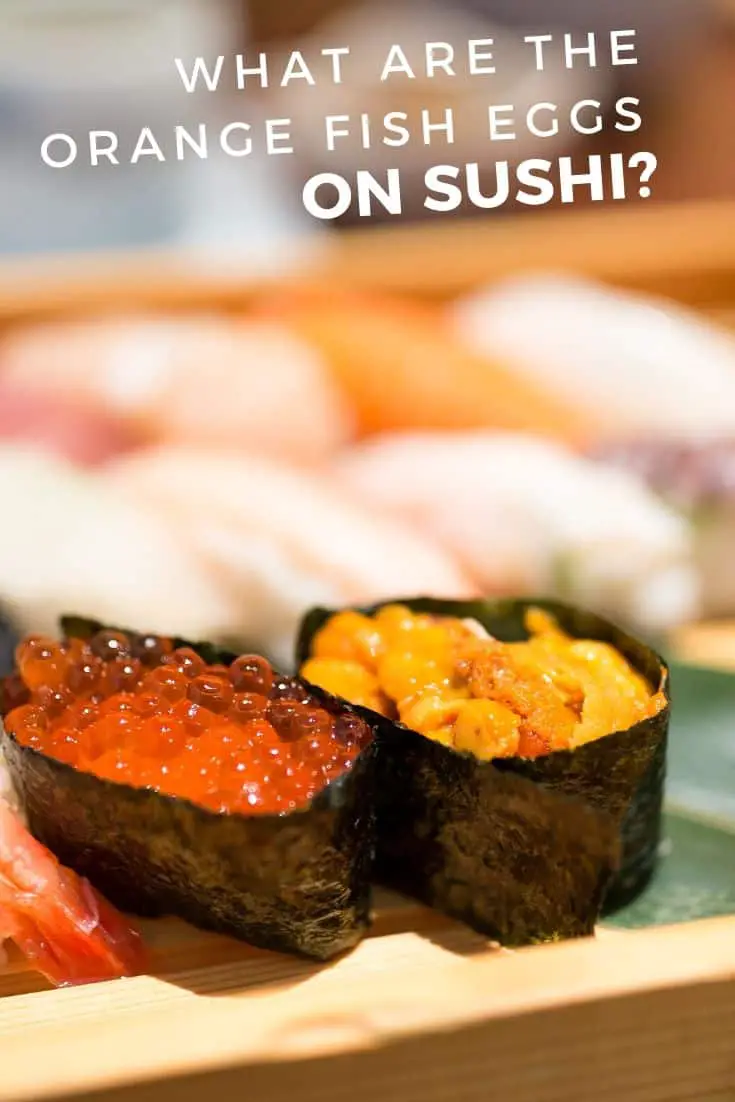
Fish roe is very similar to other egg types, and it’s rich in protein and other vitamins. Unfortunately, it also has a high amount of cholesterol.
What type of roe is used in sushi?
Those who are knowledgeable in the culinary world may know that chefs only use 3 types of fish roe in nearly all sushi bars and restaurants:
- Tobiko (とびこ, flying fish roe)
- Masago (真砂子, smelt roe)
- Ikura (イクラ, salmon roe)
When you ask people the name for fish roe in Japanese, you’ll most often hear “tobiko” (とびこ), which is flying fish roe, which is most commonly used on sushi. It’s the fish eggs’ name for this particular type and isn’t a general name like we use “roe” to describe eggs from all types of fish.
Roe is a garnish, mostly for fish and other seafood.
The chef can prepare roe in a few different ways, depending on the fish/aquatic egg type and which flavors may suit them.
Chefs can use roe both ways: fresh or cooked. Even though many dishes use cooked roe, tobiko, masago, or ikura fish roe on sushi is almost always served raw.
Is tobiko safe to eat?
Eating tobiko roe is good for your health, just as long as you consume it moderately (eating too much of it might raise your cholesterol levels).
According to the US Department of Agriculture, fish roe is rich in proteins and amino acids. It’s also low in calories and is abundant in minerals and nutrients, such as magnesium, selenium, and vitamin B-12, which are very beneficial to your health. However, the amount and availability of them may vary between the various roe types.
Also present in fish roe are the unsaturated fatty acids known as omega-3s, which are good for the heart. Omega-3 fatty acids have anti-inflammatory properties that can help protect your body (especially your brain) from oxides that cause harm at the molecular level.
A peer-reviewed scientific journal called the Journal of Food Science and Technology included new research that discovered that roe has a high amount of fat that helps the brain to improve its learning abilities. It also reduces fats in a person’s bloodstream.
Also read: is sushi always raw fish?
Are all fish roe caviar?
It’s true that all fish eggs are roe. However, not all roe is caviar!
Basically, to be considered “caviar”, the fish roe must be sturgeon eggs. So the term “sturgeon caviar” is a bit redundant!
How do they get eggs for sushi?
Roe comes from fish and other animals in the ocean. And if you’ve seen it up close, then you’d know that the eggs are roughly 1-2 mm in size.
Harvesting them from the fish or other sea animals is a challenge, as going by the process means you must first catch the fish before you can harvest the fish roe. Then you have to preserve it, ship it to the restaurant, and finally, prepare and serve it to the guests.
However, the actual process of harvesting roe may not be exactly as you’d expect, so here’s how they really do it.
What kind of fish is roe?
This is still a commonly asked question, but by now, you might know from this article that roe isn’t actually a fish. “Roe” is used to describe the eggs from different types of fish, like salmon or sturgeon.
Are fish killed for caviar?
Unfortunately, the answer to this question is a disappointing “yes”. And while preserving our natural resources is a primary concern, especially during these times when the clamor for climate change is at its loudest, fishermen have a good reason for why they do it.
Despite the modern techniques in harvesting caviar (which are in fact designed to keep the fish alive after harvesting their roe), it still doesn’t compare with the quality and consistency of roe harvested from fish that’s been killed.
Continue reading this article to find out why fishermen need to kill fish in order to harvest roe and to discover the various ways we get this precious resource from the ocean.
How is roe harvested and made into caviar?
Fish roe is harvested by using 2 special methods before they’re made into the caviar delicacy that you know and love.
1. The classic harvesting method
The classic method for harvesting roe has been around since ancient times and it’s still done the same way today.
Even though scientific advances have been made in the areas of farming, fishing, and production technology, the general practice of harvesting roe has remained the same. And the step-by-step process that people used centuries ago has been handed down to their descendants up until recent times.
PETA, alongside many other animal rights activist movements, criticizes the traditional Russian and Iranian roe harvesting technique and deems it inhumane and cruel to animals.
Marine biologists confirmed that wild sturgeon populations have been steadily declining and might face extinction soon.
The reason why animal rights activists protest this method so much is because it requires the sturgeon (or other fish) to be killed to harvest its eggs in the best possible condition.
In modern fish farms and fisheries, the female fish that carry the roe are placed in ice-cold waters to minimize their movements until they become unconscious and completely immobilized. Then their roe’s harvested.
Only purified water is used to clean the fish and then an incision is made in the length of the belly of the fish.
Most fish have 2 roe sacks. The handlers remove the eggs from the sacks before the fish completely dies.
If they delay the extraction of the roe, then the dead fish will release a chemical that otherwise harms the eggs, rendering them useless.
After the egg sacks are removed from the fish, they’re cleaned and placed in a container to be shipped to sushi restaurants later on, while the fish is processed for meat harvesting.
Each roe sack (or skein from salmon or trout eggs) is filtered through a sieve to do away with the membrane and keep only the fish eggs. Once the membrane’s been separated from the eggs, then they’re washed and filtered again (they look like tiny green eggs).
Lastly, they’re set aside to drain any moisture left and then they’re weighed, salt-cured, and graded.
2. The humane harvesting method
A new method of harvesting fish roe that’s safer than the classic one (one that allows handlers to get the roe without killing the fish) is called the humane harvesting method.
This fish farming technology is sometimes called “anti-cruelty” or “no-kill” caviar and it uses hormone therapy combined with milking techniques, as well as basic surgery to harvest the fish roe without killing the fish. This allows fish farmers to harvest eggs multiple times and not have to worry about catching or buying new fish, unlike what they do in the classic harvesting method.
It’s unfortunate that all unfertilized sturgeon eggs are inedible as soon as they’re removed from the mother fish’s sack and get contaminated by water (whether salty or fresh). This is due to the network of cells that keeps fish roe stable while in the sack. This also decreases its quality and is no longer viable for making caviar.
This is why the traditional harvesting method for fish roe requires the mother fish to be killed off. This allows the fish farmer to get the eggs from the sack while still immature.
Recently, an altered fish breeding reproduction method was invented by a German marine biologist, Angela Köhler (known for introducing the Köhler process, which is a modified fish-milking method that’s now being used in the caviar industry). It allows fish farms to harvest fish roe to make caviar without harming the mother fish.
The Köhler process is done by injecting the ovulating fish with a protein or hormone that’s a similar naturally-occurring chemical, which separates the egg sack membranes from the fish eggs in the belly cavity of the mother fish. The same process happens in the natural pregnancy cycle of the fish right before the eggs are delivered.
If the fish farmer senses that the fish might suffer some potential stress during the process, then they may put it on ice or sedate it not to damage the fish roe while it’s being harvested.
How are fish eggs removed?
The fish is rinsed with purified water and the eggs are harvested in either of these 2 ways:
- C-section method: A tiny incision is made on the belly of the female sturgeon fish and then the eggs are meticulously scooped out. After this careful process, the fish is patched up and allowed to regain consciousness. The only downside to this method is that the sturgeon is vulnerable to infections and their reproductive organs might get damaged due to the surgery.
- Vivace method: This method does away with invasive ways of extracting fish roe and instead, utilizes a fish-milking technique known as striping. This only requires someone to massage the eggs out of the fish (similar to when the fish goes through natural delivery).
The eggs are then immediately rinsed in a water-calcium solution after milking them from the pregnant mother fish.
This is done so that the fish eggs’ texture will be of the highest quality and won’t turn mush. It also makes the green roe able to withstand further handling, salting, and curing.
The green fish roe is then tested to see if it’s firm enough to go through more processes along the production line, and then it’s washed and filtered. It’s drained to remove as much water as possible, then weighed, salt-cured, and graded.
Even though the classic method of harvesting fish roe has been historically considered the standard practice in making caviar, the anti-cruelty method is more appealing to animal rights activists, as it’s more efficient and helps sustain endangered fish species.
It takes about a decade before sturgeons are old enough to undergo fertilization. Also, their eggs can live for almost a century, so it’s only logical to keep them alive to extract their eggs for a much longer time.
In addition to saving the flora and fauna of this planet, keeping the same female fish to produce eggs seasonally is also cost-effective for fish farms.
Despite the potential benefits of utilizing the humane method in harvesting roe, most fish farms still use the classic method. This may be due to the lack of information across the fishing industry and/or people still preferring the classic method.
The no-kill method of harvesting caviar also requires fish farms to invest in hormones, chemicals, and equipment necessary to perform a seamless operation. Unfortunately, fish farmers look at this as a financial liability, which also makes them prefer the classic method instead.
If conservationists and animal rights activists deem traditional caviar as inhumane and unethical, this also poses a problem. Certain people, such as pregnant women, will have to say “no” to no-kill caviar due to the hormones and/or proteins used to extract the roe.
What are the different types of fish eggs?
Tobiko (flying fish roe)
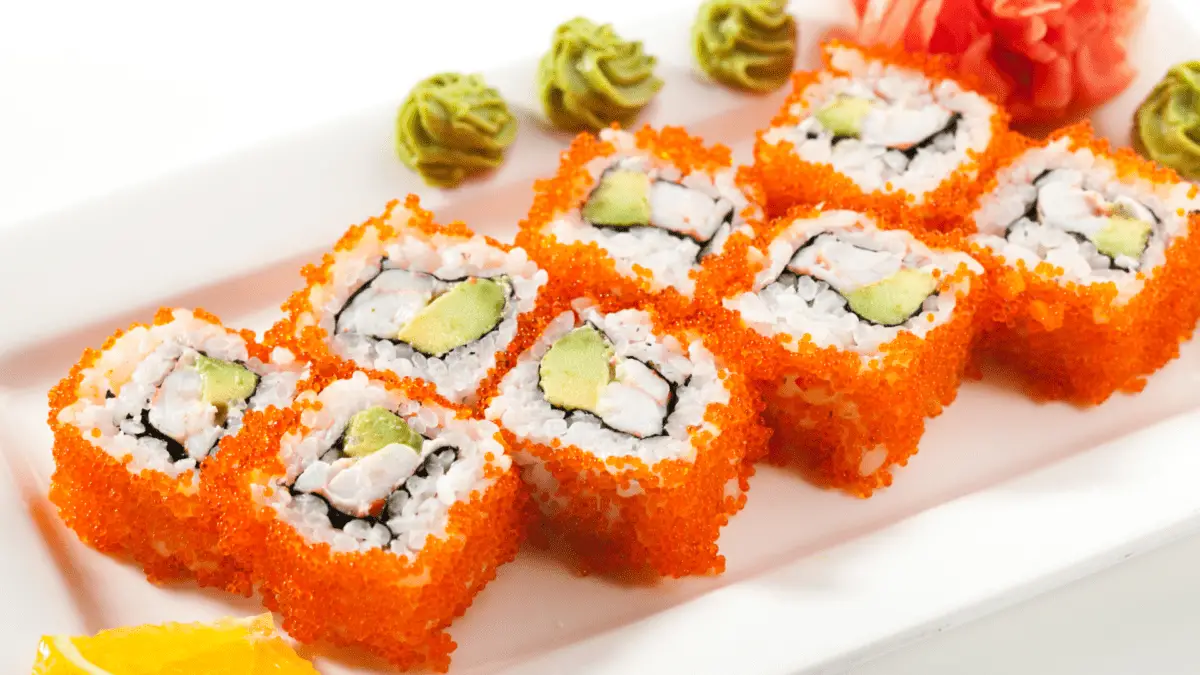
“Tobiko” is the Japanese word for “flying fish roe”.
Tokibo fish eggs are small, measuring between 0.5 to 0.8 mm in diameter. They possess a red-orange color, salty/smoky flavor, and are crunchy to the bite.
It’s commonly found in California rolls, but it’s also used as a garnish when making sushi. It usually goes on top of the sushi rice!
Masago (smelt roe)
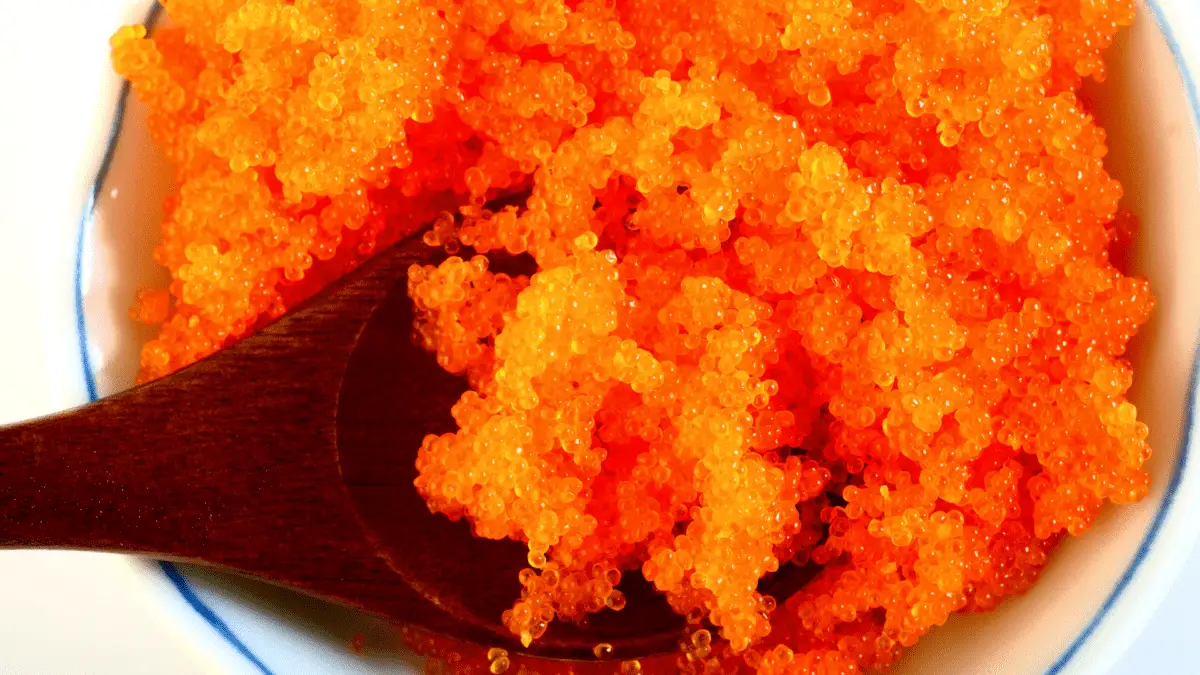
Smelt roe, or “masago”, as the Japanese call it, are the caplin fish’s edible eggs commonly used in making sushi and sashimi.
Marine biologists have classified them as forage fish, which are considered prey to larger predators like codfish, seabirds, seals, and whales. These small, silvery-green fish closely resemble sardines.
Capelin is an edible fish, just like most other known fish species. However, fishermen want it for its eggs or roe more than any other reason.
About 80% of the capelin fish caught is used to create fishmeal and fish-oil products, while the remaining 20% is used for harvesting their roe.
The females of the capelin fish start to ovulate when they reach 2-4 years of age and continue to for the rest of their lives.
Fish farmers wait until the female capelin fish are full of eggs and then harvest them prior to when they spawn.
Masago is commonly used as one of the ingredients of sushi and it has a light yellow color, although chefs dye it with colors like orange, red, or green in order to add visual aesthetics to their sushi dishes.
It has a mild flavor and sometimes, sushi chefs mix it with ingredients for condiments such as wasabi, squid ink, or ginger.
Ikura (salmon roe)
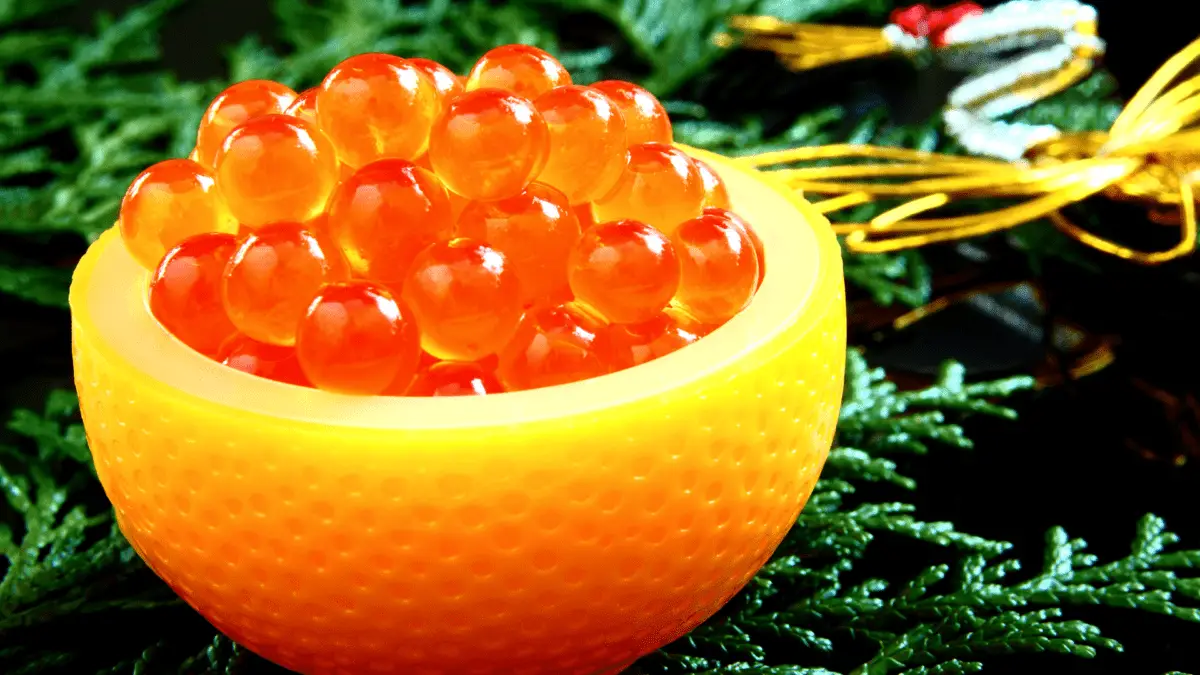
Ikura is large bubbly red-orange spheres that are larger than most fish and seafood roes. “Ikura” is actually a borrowed Russian word “икра,” which means “soft-shelled eggs”, used only in the context to describe caviar.
Since salmon eggs are also used as fish bait, fishing and outdoor-loving buffs might be surprised to find salmon roe served in their food.
Ikura is commonly used by sushi chefs to garnish sushi rolls. It’s used not only to add aesthetic appeal to the sushi dish, but to ao add extra flavors in order to satiate the customer’s appetite.
A common misconception about caviar is that it’s an expensive or fancy food. However, it’s actually a common food in Japan.
Salmon roe is more affordable than other types of caviar because it’s more accessible. You can actually find ikura in just about every supermarket and convenience store in Japan.
Doctors and medical professionals actually recommend that you consume ikura moderately, as it’s rich in omega-3 fatty acids.
If you’d like to read more about sushi rolls and their calories, you should read this article I’ve written on the different types of rolls and their calorie counts.
Tarako (pollock roe)
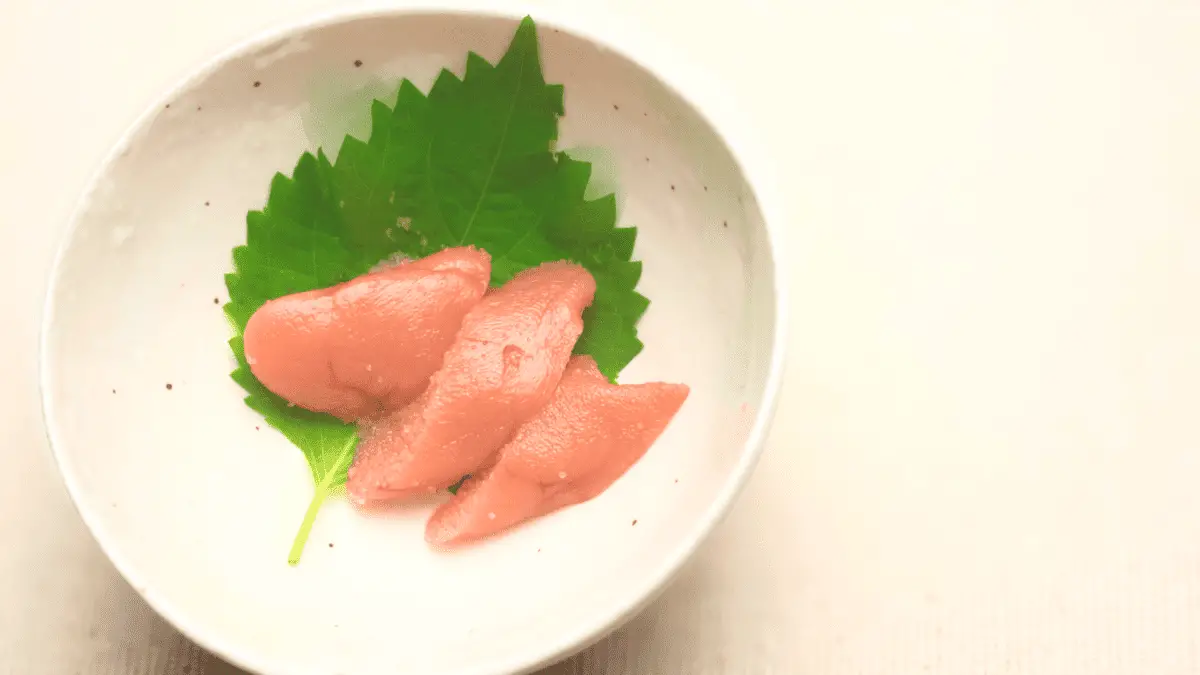
Tarako is plain, salted sacks of pollock or cod roe. These tiny egg sacks are known for their incredibly tender texture, mild to neutral flavor, and light pink color.
You can eat it plain or mixed with other recipes, such as sushi and sashimi. It’s also used to make spaghetti sauce, except it’s cooked to add flavor to the sauce.
Mentaiko
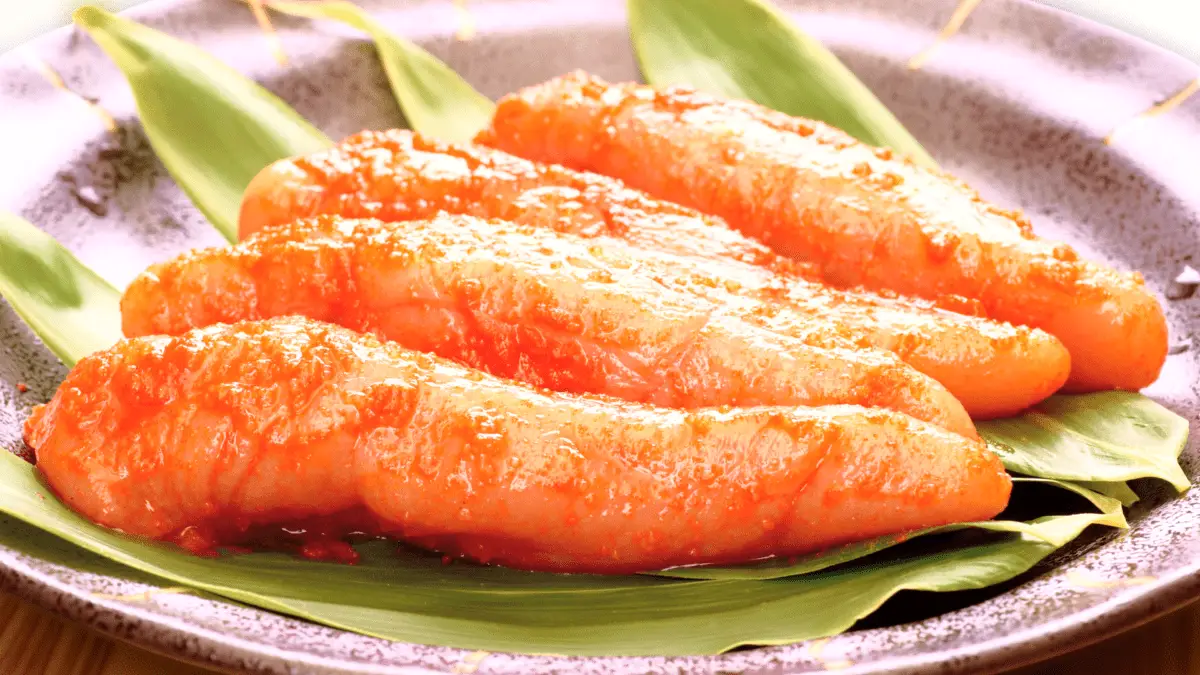
Mentaiko is actually a type of tarako.
It’s called mentaiko (a common ingredient in traditional Japanese cuisine) when it’s marinated with salt and chili peppers.
Sujiko (salmon roe that’s still within its egg sack)
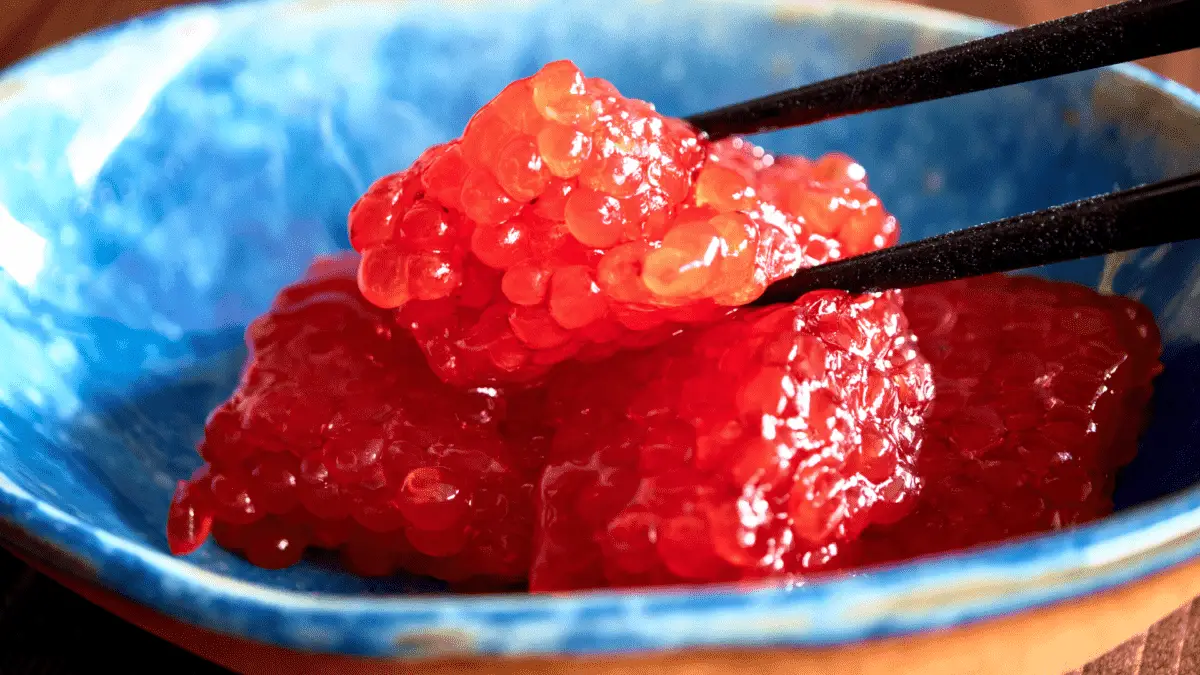
Sujiko is different from ikura because the fish eggs are still inside the egg sack when it’s consumed, while ikura is served as individual eggs. It’s usually served with rice in onigiri dishes (a favorite rice cake in Japan).
When sujiko is cured, it’s almost difficult to tell the difference between it and ikura, as they have similar tastes and textures.
Sujiko kasuzuke (sujiko mixed with sake kazu) can be eaten plain without any added ingredients. It tastes even better with wine or sake.
I’ve written this post on some of the best sake brands you can use for cooking, so be sure to check that out as well.
Kazunoko (herring eggs)
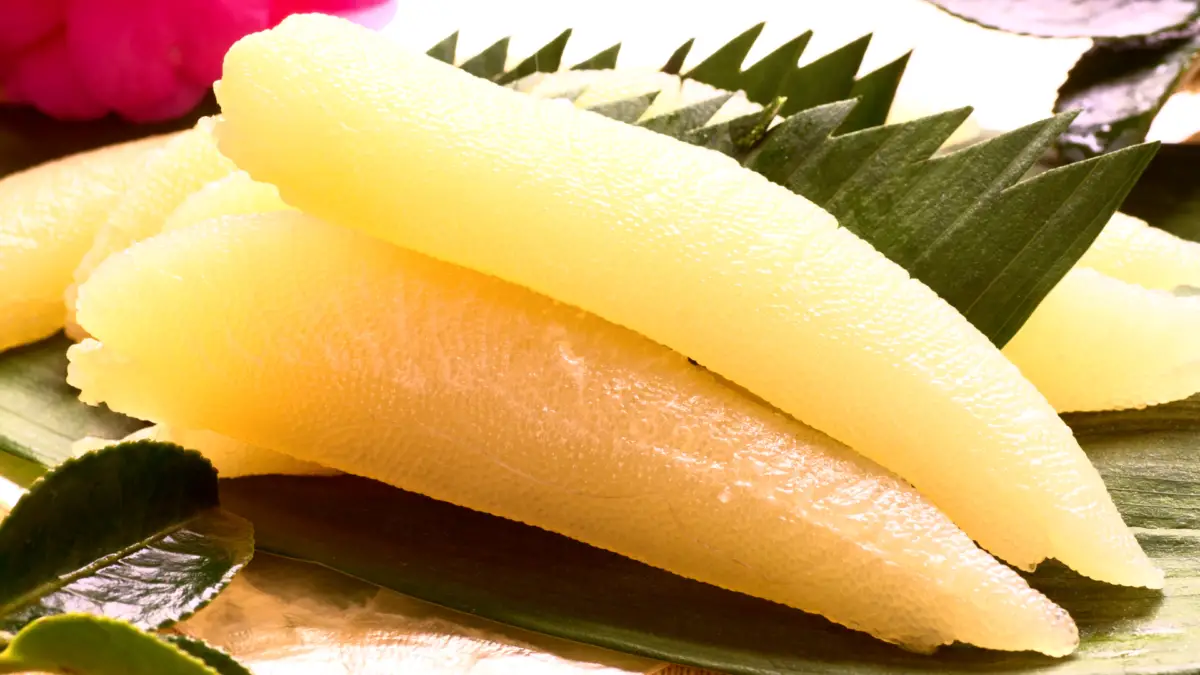
During osechi ryori (which is the Japanese new year), kazunoko is a popular dish among locals and they consider this dish as something that’ll bring them good fortune. It’s herring roe that’s marinated in dashi soy sauce seasoning. Kazunoko has the combined flavor of umami (from the dashi), salt, and soy sauce.
The tiny herring roe has a lovely golden color and it’s crunchy to the bite.
Paddlefish caviar
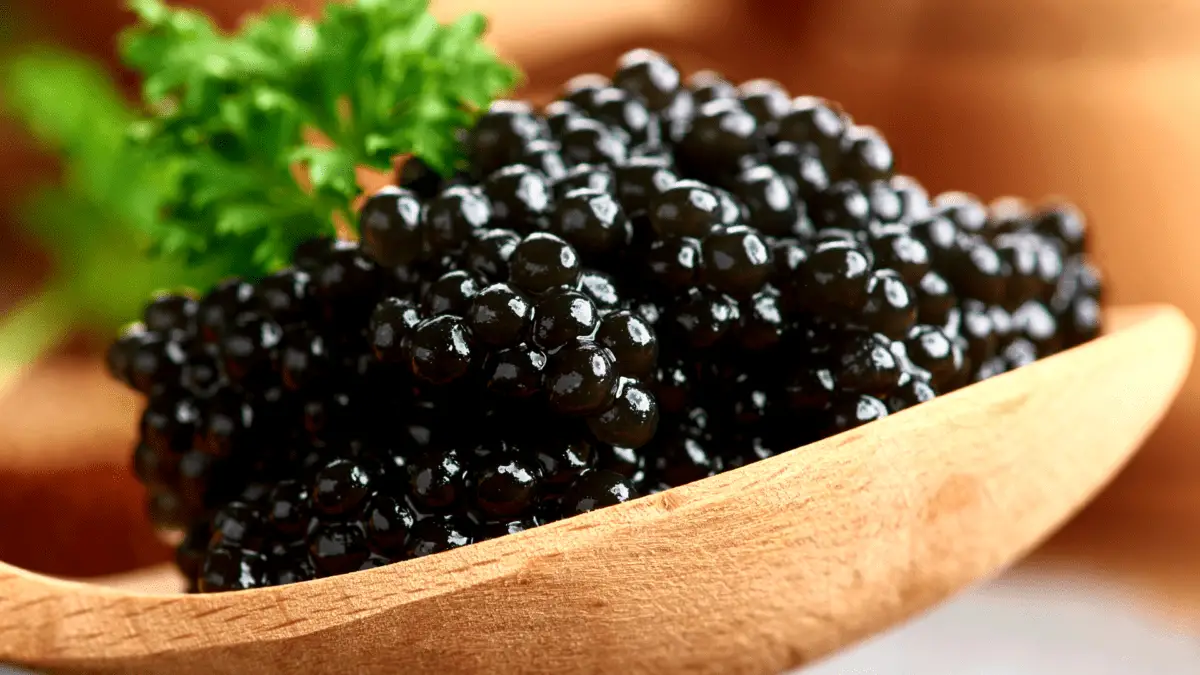
An inexpensive alternative to sturgeon caviar, paddlefish caviar is also called “spoonbill” caviar, as the fish has a bill similar to a duck’s.
Paddlefish caviar is harvested from freshwater sturgeon in the United States. It’s considered a good caviar to start with when you’re a beginner to the sushi and caviar world.
Whitefish caviar
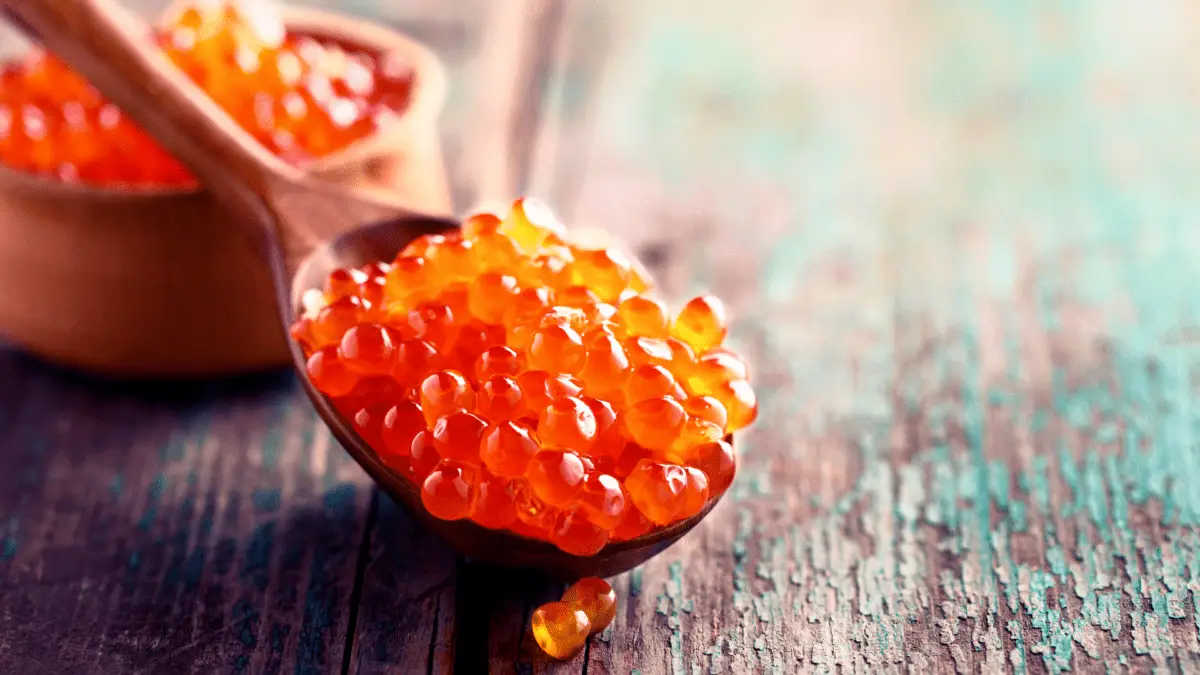
Whitefish is only found in the Great Lakes of North America. Its eggs have a golden hue, are very small, have no trace of fish flavor, and are mild to the taste.
The fish eggs are also crunchy to the bite and are quite popular in Scandinavia. The people call it sirkom in the Dano-Norwegian language.
Whitefish caviar is a versatile raw food material that goes well with a multitude of recipes, including soups and sauces.
Bowfin caviar
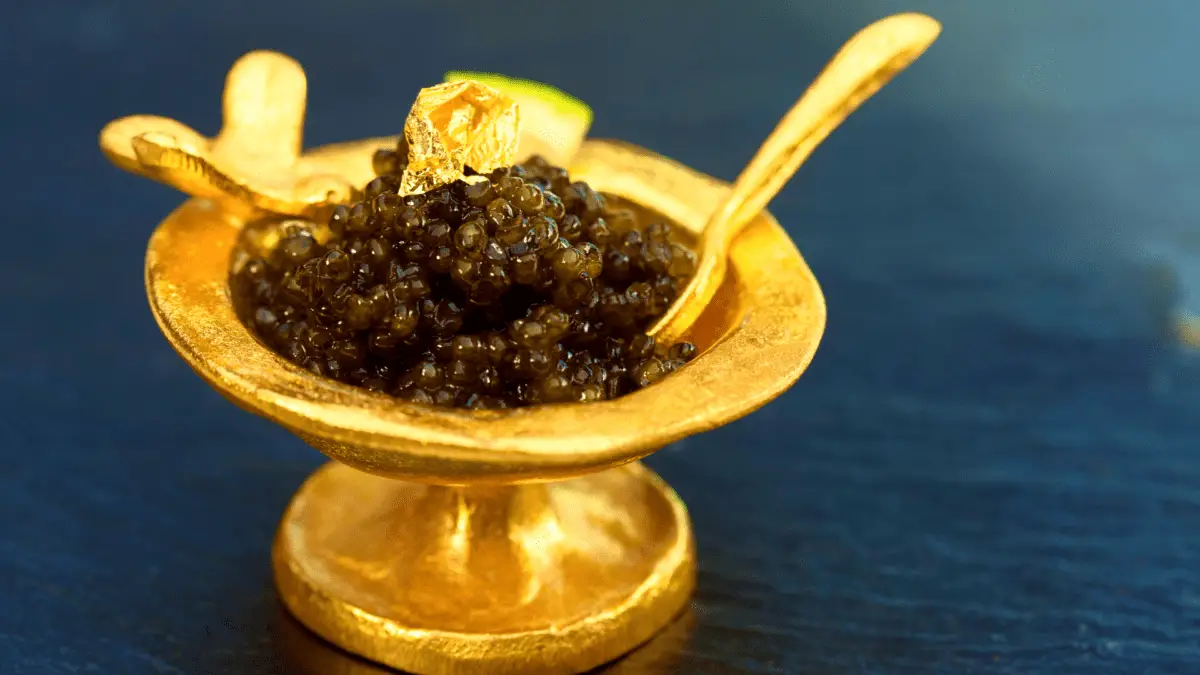
Bowfin caviar also is known as Cajun caviar. And with its local Cajun name “choupique,” it’s been popular in Louisiana since the 15th century AD.
The bowfin is a freshwater fish native to North America. Although it doesn’t belong to the sturgeon species, it’s known to have high-quality yet affordable roe.
Bowfin caviar is a great garnish for sushi and sashimi recipes. But it’s also used to make baked goods and the fish roe turns red when cooked.
Black lumpfish caviar
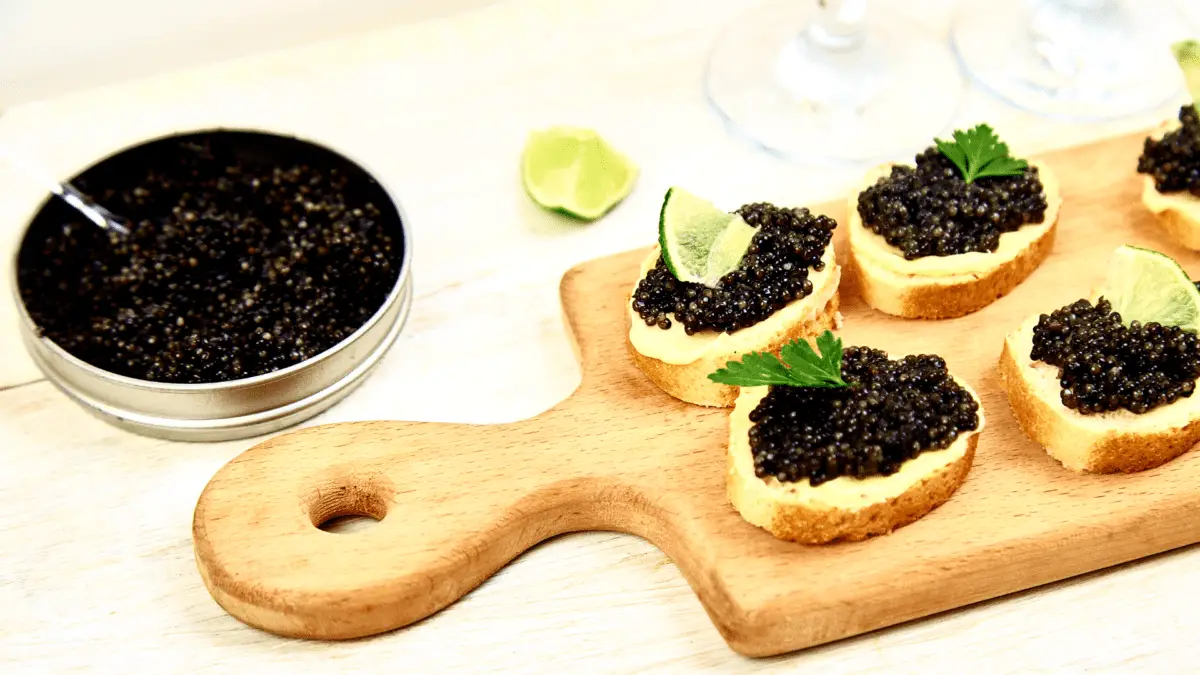
If you’re looking for an inexpensive yet very delicious entry-level caviar that’s great for gourmet meal recipes, then black lumpfish caviar would be the best choice.
Black lumpfish roe is smaller than regular fish roe. Enjoy eating it from the jar, on canapes, or in sushi.
It has a strong salty fish flavor and is crunchy to the bite.
Trout caviar
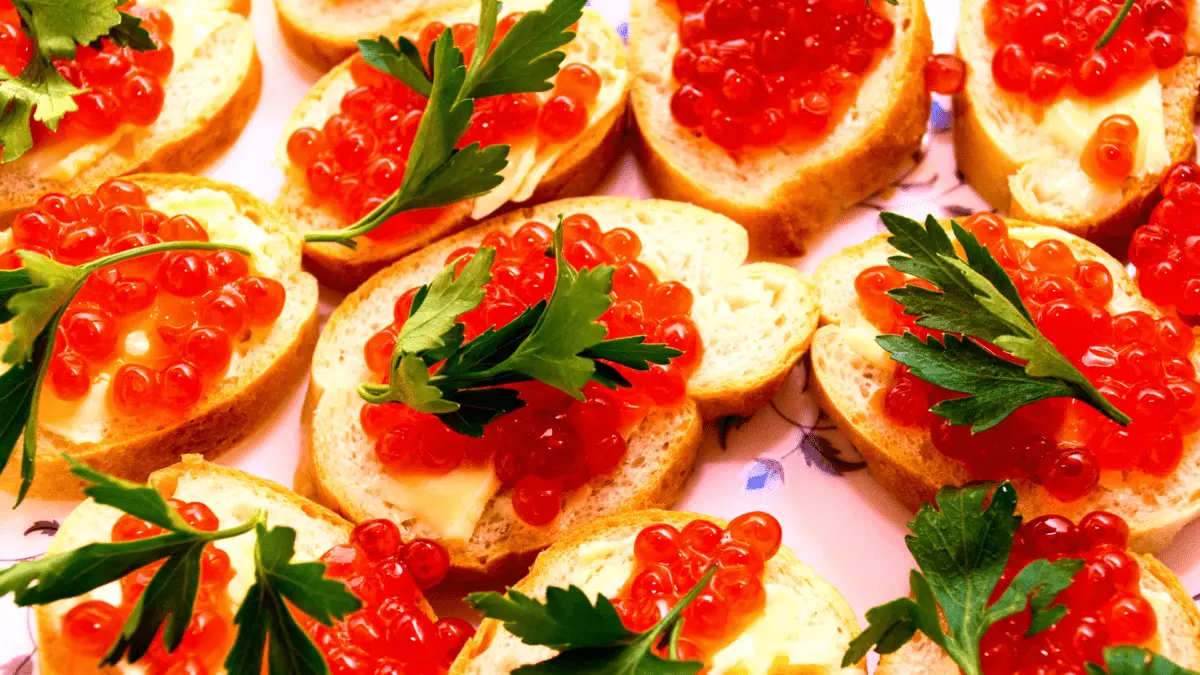
Although there are wild European rainbow trout, some are bred in aqua farms. Those are raised following all animal welfare laws strictly.
These eggs give off a bright orange color and have a smokey sweet flavor.
Trout caviar is great for canapé, fish, shellfish, and eggs. This is one of the most versatile types of fish caviar and it works well with almost any dish.
Tuna bottarga
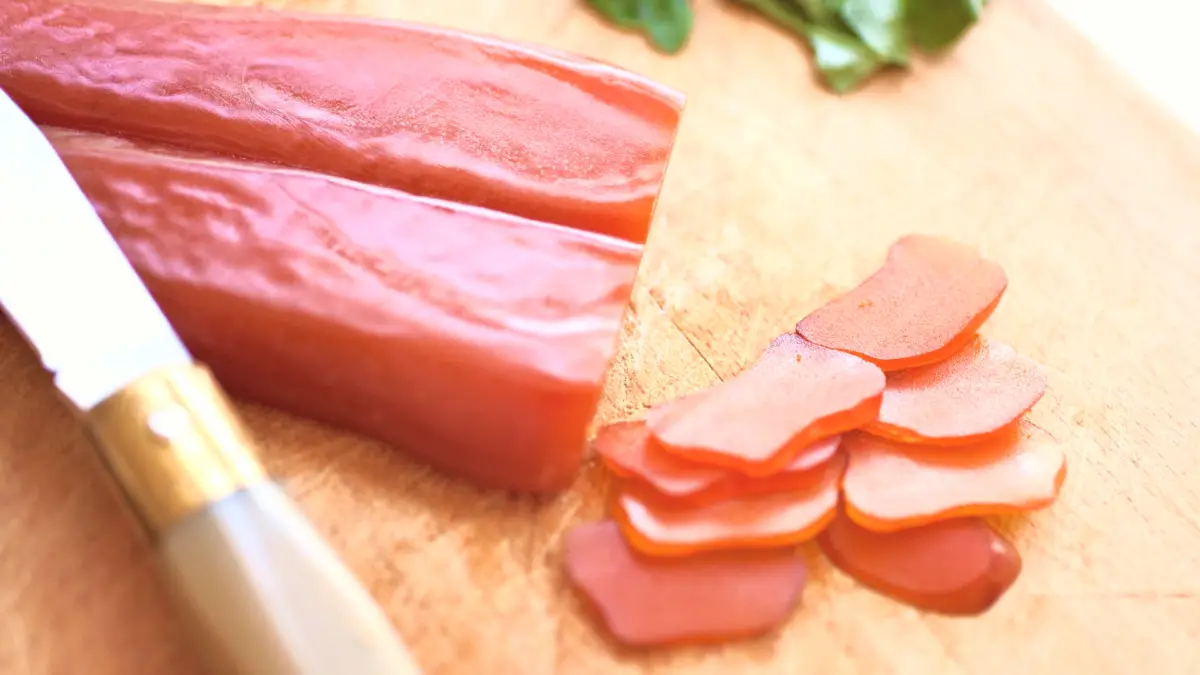
Bottarga is a delicacy of salted, cured fish roe that comes from bluefin tuna or the gray mullet’s dried egg sack.
Bottarga has different names across different countries, where it’s produced and it’s prepared in different ways as well! For instance, the Japanese call it “karasumi” (softer than the Mediterranean version) and the Koreans call their bottarga “eoran” (made from freshwater drum or mullet).
However, the Mediterranean version of bottarga is known to be the best of all types of bottarga.
Uni (sea urchin roe)
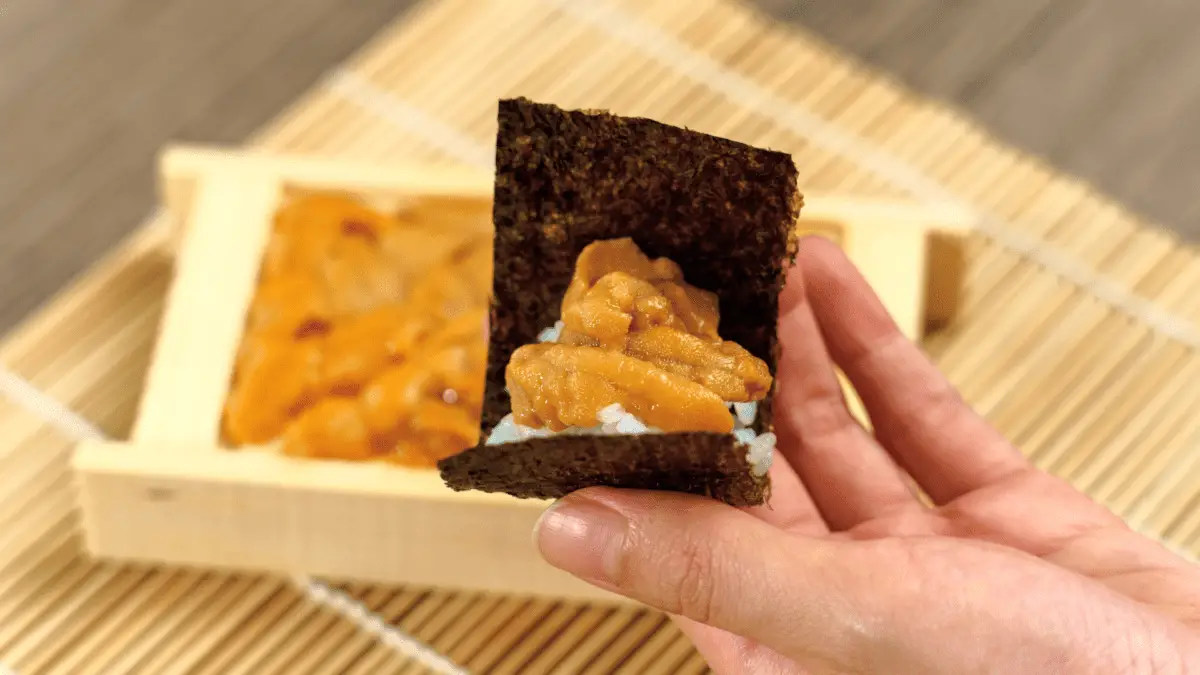
Uni is what the Japanese call the edible part of sea urchin roe. Although often called roe (eggs), uni is actually the animal’s reproductive organ, which produces eggs or milt.
The color of uni ranges from rich gold to light yellow. And the milt produces a creamy liquid that may put off some people and may make others enjoy it.
However, the demand for this type of roe is so high that it costs $110-$150 per tray alone in US fish markets.
You’re now a sushi fish eggs name pro
The next time you want to eat roe, you know a bunch of fish eggs name choices. From tobiko and masago to the different types of caviar, you’ll have a great time trying them all!
Check out my post on all of the different types of American and Japanese sushi for more on the differences between the two.
Check out our new cookbook
Bitemybun's family recipes with complete meal planner and recipe guide.
Try it out for free with Kindle Unlimited:
Read for freeJoost Nusselder, the founder of Bite My Bun is a content marketer, dad and loves trying out new food with Japanese food at the heart of his passion, and together with his team he's been creating in-depth blog articles since 2016 to help loyal readers with recipes and cooking tips.
